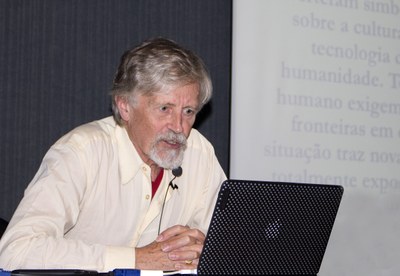The centrality of technology in the contemporary world
 Technological development has been causing such deep transformations in contemporary society as those experienced during the Renaissance. In the Renaissance, however, the trigger of the transition was humanism, responsible for modifying the relationship between man and the natural world. Now it’s technology, converted into a new totem, that occupies the central place formerly belonged to nature and creates new parameters to set the human being.
Technological development has been causing such deep transformations in contemporary society as those experienced during the Renaissance. In the Renaissance, however, the trigger of the transition was humanism, responsible for modifying the relationship between man and the natural world. Now it’s technology, converted into a new totem, that occupies the central place formerly belonged to nature and creates new parameters to set the human being.
In summary, this is the idea behind the ‘technototemism’ theory developed by sociologist Derrick de Kerckhove and presented by him at the conference ‘Technology: the New Totemism’, held by the IEA on October 17 and coordinated by anthropologist Massimo Canevacci, visiting professor at the institute.
Disciple of Canadian theorist Marshall McLuhan (1911-1980), Kerckhove is considered one of the most important researcherss of the relationship between digital technologies and society. He teaches at the University of Toronto, where he has directed the McLuhan Program in Culture and Technology for more than 20 years.
USER vs. CONTENT
To support his theory, Kerckhove sought inspiration in the thought of French anthropologist Phillip Descola, more specifically the concept of totemism - form of identification between man and the natural world marked by the absence of rupture between culture (human) and nature (non-human).
Transposed to the context of a technological society, totemism translates itself into continuity between mind (man) and machine (technology), according to Kerckhove. For the sociologist, that continuity brings out the Mcluhanian statement that media condition both the interiority as the externality of individuals, so that the user becomes content .
‘There is an interdependence between the self and the networked world: technology has become an extension of the body and a defining element of human identity’, he said, noting that the most symptomatic effect of this is the proliferation of identities in the network, such as digital people, avatars, identification numbers and electronic entities, among others. According to him, there is maybe an ongoing process of anthropological mutation triggered by the emergence of the digital IT, as suggested by French theorist Pierre Lévy.
CENTRALITY OF NETWORKS
To illustrate the centrality of networks in the process of mutation, Kerckhove has compared the internet to the limbic system - a component of the nervous system responsible for the control of emotional behavior and motivational impulses, i.e., the mechanism by which an emotion leads to a process of decision-making and, after this, an action.
According to the sociologist ‘we are moving from biology to technology: the internet works as a global limbic system because it brings out emotions and passions able to culminate in actions with viral progression’. To exemplify, he has mentioned movements that have gained strength in the networks, such as the Arab Spring, Indignados, Anonymous, Occupy Wall Street, in addition to the global activism initiated by Wikileaks and carried forward by Edward Snowden.
CONNECTION OF MINDS
‘When communicating through the internet, people connect their minds and share thoughts, composing a kind of digital unconsciousness’, said Kerckhove, introducing what he claimed to be his contribution to the theory of Freud. The sociologist said that while there is no way to prove the existence of the unconsciousness, ‘the digital unconsciousness is there, composed of all that is known about anyone on the network’. For him, this phenomenon is becoming as crucial in the lives of people as paternal and maternal influences.
The digital unconsciousness would, according to the speaker, arise from a hybridization between real and virtual, marked by reduced interiority, connected to the self, and an extended externality linked to the networked world. For Kerckhove, it is the result of a new emotional anxiety. ‘What is Web 2.0 but the entry of the excitement factor in an environment where there was only information? People want to share news and also feelings, tips, thoughts, opinions’, he said.
But the sociologist warns that analyzing this new reality requires a dose of skepticism, because the sharing of content, the exponential multiplication of the number of emitters in the media, the possibility to express outrage, the increasing transparency of information, the expanding of transculturalism, among others, all come at a high cost: privacy. According to the lecturer, in the era of technological totemism, trying to have control over personal information posted on the internet is like rowing against the tide.
